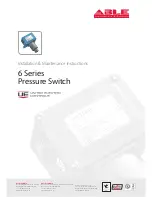
2-14
Catalyst 4500 E-Series Switches Installation Guide
OL-13972-02
Chapter 2 Preparing for Installation
Power Requirements
•
If you are using a 200/240 VAC power source in North America, the circuit must be protected by a
two-pole circuit breaker.
•
The source AC outlet must be within 6 feet (1.8 meters) of the system and should be easily
accessible.
•
The AC power receptacles used to plug in the chassis must be the grounding type. The grounding
conductors that connect to the receptacles should connect to protective earth ground at the service
equipment.
Power Connection Guidelines for DC-Powered Systems
This section provides the basic guidelines for connecting the Catalyst 4500 E-series switch DC-input
power supplies to the site power source:
•
All power connection wiring should conform to the rules and regulations in the National Electrical
Code (NEC), as well as any local codes.
•
DC (–) and the DC return (+) terminals are evaluated for use with 1/0 AWG wire (1400 W DC supply
only).
•
The ground terminal is evaluated for use with 6 AWG wire (10 AWG for the multi-input power
supply).
•
The DC return must remain isolated from the system frame and the chassis (DC-I).
•
For DC power cables, we recommend that you use commensurately rated, high-strand-count copper
wire cable. Connection to the DC-input power supply requires one earth ground cable, one source
DC (–), and one source DC return (+). The length of the cables depends on your switch location.
These cables are not available from Cisco Systems. They are available from any commercial cable
vendor.
•
The color coding of the source DC power cable leads depends on the color coding of the site DC
power source. Typically, green or green and yellow indicate that the cable is a ground cable. Because
there is no color code standard for source DC wiring, you must ensure that the power cables are
connected to the DC-input power supply terminal block in the proper (+) and (–) polarity. In some
cases, the source DC cable leads might have a positive (+) or a negative (–) label. This label is a
relatively safe indication of the polarity, but you must verify the polarity by measuring the voltage
between the DC cable leads. When making the measurement, the positive (+) lead and the negative
(–) lead must always match the (+) and (–) labels on the DC-input power supply terminal block.
•
DC power cables must be terminated by cable lugs at the power supply end.
•
The circuit breaker is considered to be the disconnect device and should be easily accessible.
•
The circuit must be protected by a dedicated two-pole circuit breaker. The circuit breaker should be
sized according to the power supply input rating and local or national code requirements.
•
For proper DC-input redundant power configurations on systems with multiple-input DC-input
power supplies, all pairs of source DC cables for one DC-input power supply must come from the
same battery system (A feed); all pairs of source DC cables for the second DC-input power supply
must come from a different battery system (B feed).
•
For DC-input power supplies with multiple inputs, each DC input must be protected by a dedicated
circuit breaker or a fuse. The circuit breaker or the fuse must be sized according to the power supply
input rating and local or national electrical codes.
















































